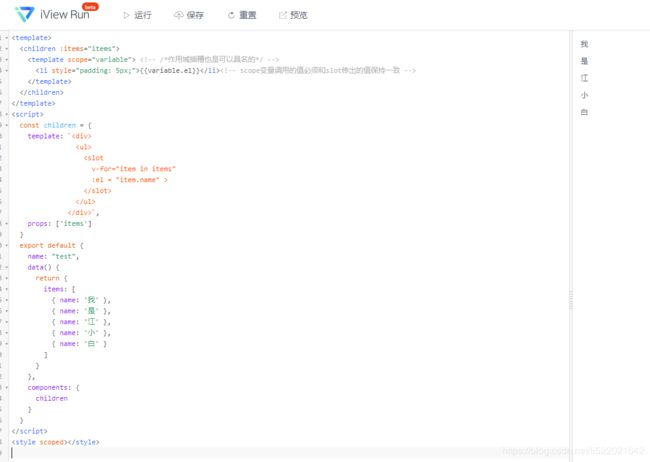Slot使用
slot 的简单使用
为什么要使用slot?
如果项目中需要一个模态框提示 付款成功,付款失败。那么这个模态框也就仅仅差这几个字或者是状态图片而已。那么此时应用solt就是一个非常不错的选择,说白了就是,在使用相同组件的时候可以通过slot了展现不同的效果。
单个 slot
下面是一个没有加入 slot 的 例子
<template>
<children>父组件的内容</children>
</template>
<script>
const children = {
template: `这里是子组件`
}
export default {
name: "test",
components: {
children
}
}
</script>
可以看到 我们在 children 组件中加入了一段话,但是班没有显示出来,因为 子组件中 没有放置我们在 父组件 中的文字的 位置,所以我们需要改动一下
加入slot 效果
<template>
<children>父组件的内容</children>
</template>
<script>
const children = {
template: `这里的效果是很明显,我们在父组件里面添加的文字被 正常的显示出来
具名slot
上面是当组件的模板中有一个slot的情况,那么一个组件中如果想使用多个slot那么此时就应该使用具名slot。
slot 元素可以用一个特殊的属性 name 来配置如何分发内容。多个 slot 可以有不同的名字。具名 slot 将匹配内容片段中有对应 slot 特性的元素。
仍然可以有一个匿名 slot ,它是默认 slot ,作为找不到匹配的内容片段的备用插槽。如果没有默认的 slot ,这些找不到匹配的内容片段将被抛弃。
<template>
<children>
<div slot="header">父组件添加的头部</div>
<div>这里是默认的slot的内容</div>
<div slot="footer">父组件添加的底部</div>
</children>
</template>
<script>
const children = {
template: `
这是子组件默认的信息
很简单是吧,下面来看看 作用域插槽
作用域插槽
作用域插槽的数据由父组件决定,内容却由子组件控制。简单来说:作用域插槽是一个带绑定数据的插槽
调用父组件数据
<template>
<children :items="items">
<template scope="variable"> <!-- 作用域插槽也是可以具名的 -->
<li style="padding: 5px;">{{variable.el}}</li><!-- scope变量调用的值必须和slot传出的值保持一致 -->
</template>
</children>
</template>
<script>
const children = {
template: `
`,
props: ['items']
}
export default {
name: "test",
data() {
return {
items: [
{ name: '我' },
{ name: '是' },
{ name: '江' },
{ name: '小' },
{ name: '白' }
]
}
},
components: {
children
}
}
</script>
<style scoped></style>
调用子组件数据
<template>
<children>
<ul slot-scope="data">
<li v-for="(item, index) in data.data" :key="index">{{item.name}}</li>
</ul>
</children>
</template>
<script>
const children = {
template: `
最后贴一个基于 iview 的Modal组件的使用示例
iview Modal 示例




